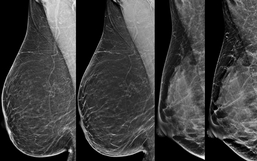Synthesized Mammography Effective in Assessing Breast Density
Monday, Nov. 27, 2017

Haider
Synthesized mammography is comparable to full field digital mammography (FFDM) when assessing breast density, according to research presented Sunday.
A new study from the University of Utah, Salt Lake City, showed that at least four out of seven readers made the same density determinations in 88 percent of the cases studied, regardless of the image type. However, imaging readers showed a slight tendency to assign higher densities when they were looking at synthesized images than at FFDM images.
Breast density has implications both for cancer risk and for the ability to detect the disease during imaging.
Synthesized mammography is a relatively new technique that uses software to reconstruct the 3-D images that are generated during digital breast tomosynthesis into 2-D images, offering views comparable to 2-D FFDM images.
Each of the two image types has a distinctive "look" that's easily recognized by the reader, said presenter Irfanullah Haider, MD, who was a breast imaging fellow at the University of Utah at the time of the study and is now an instructor in breast imaging at Brigham and Women's Hospital, Boston. "The synthesized images have higher contrast, and calcifications tend to 'pop,'" he said.
The university routinely performs both types of imaging when doing a baseline mammogram for a new patient. Dr. Haider said one purpose of the study is to start building evidence on whether synthesized mammography can safely replace FFDM. Also, other studies have shown that patients are less likely to be recalled when using tomosynthesis, from which synthetic mammogram is derived.
In the retrospective study, seven radiologists read both baseline studies for about 200 patients whose mammograms were performed consecutively between June and November, 2016. Six of the readers had completed fellowships in breast imaging and the seventh was in a breast imaging fellowship at the time of the study.
The readers first assigned density using the randomized FFDM images alone, blinded to evaluations by other readers, and then assigned density using the synthetic views alone (also blinded to the evaluations of others) during a separate session.
Each study included four views. The study compared how often the readers agreed on the density classification, and whether their assessments and the rate of agreement, differed significantly depending on which modality produced the images. Qualitative density assessment was based on the four categories of the Breast Imaging Reporting and Data Systems (BI-RADS) 5th Edition: 1 (fatty), 2 (scattered fibroglandular), 3 (heterogeneously dense) and 4 (extremely dense). Categories 1 and 2 are considered "non-dense" and categories 3 and 4 are considered "dense."
Consensus for a given study was defined as agreement by at least four of the seven readers. Where readers disagreed, they never varied by more than one density category in either direction, and in only eight cases was the disagreement clinically significant (defined as a change from category 2 to category 3, or from category 3 to category 2).
Inter-reader agreement was higher on the FFDM images than on the SM images (.705 vs .627), but both fell into the range of moderate agreement (.61-.80).
Several studies have compared the two modalities for tumor detection, but this is one of the largest studies examining density classification. As of the beginning of 2017, 30 states require women to be notified of their breast density and legislation is pending in five more, according to the American Society of Breast Surgeons.

Breast density examples, left to right: (1) An almost entirely fatty dense breast on standard digital mammogram and on (2) synthetic mammogram; (3) an extremely dense breast on standard digital mammogram and on (4) synthetic mammogram.




 Home
Home Program
Program
 Exhibitors
Exhibitors My Meeting
My Meeting
 Digital Posters
Digital Posters Case of Day
Case of Day

